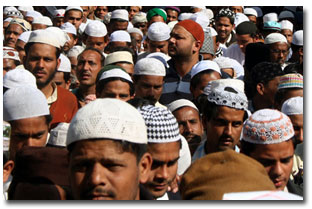|
|

|
|

|
|||
|
 ,
Agra and Rohilkhand and in the eastern districts in the terai area, in
Gonda and Bahraich, in Azamgarh, Jaunpur and Ghazipur. ,
Agra and Rohilkhand and in the eastern districts in the terai area, in
Gonda and Bahraich, in Azamgarh, Jaunpur and Ghazipur.
The fertile plains of Uttar Pradesh offered an ideal habitat for the early Muslim settlers who came in the wake of the establishment of Turkish rule in India. The hostility was confined mainly within the ruling classes - The Rajas, Rawats, Rais and the original village echelons and the muqtis and their subordinates. Years before the Ghurid conquest of northern India, the Muslims had settled in Badaun, Bahraich, Kannauj, Unnao and Bilgram. Muslim concentration in towns was primarily due to their socio-political organizations, their exclusive racial and religious complexion. Muslims have always had an influential upper class consisting of Nawabs, Rajas and Chaudhries because of their historical antecedents. Included in this class, before zamindari abolition, was a large retinue of personal staff and hangers-on (musahibs) who maintained the airs of their aristocratic masters and liked to be classified along with them. The middle class, comparatively thin among Muslims, is engaged in the traditional trades like leather, timber (in the terai area), tobacco and perfume (in Lucknow). There is only a sprinkling of Muslims in the services and professions. Commerce and trade was not a Muslim forte. Muslims have overwhelmingly large lower class, appallingly poor, conservative and hide-bound. It consists of artisans, petty traders, weavers, carpet makers, labourers, butchers, hide-flayers, vegetable-settlers and the like. They have no independent thinking and are guided solely by their religious leaders. The Muslims are stratified into four broad divisions. There were Sayyid, Shaikh, Mughal and Pathan.
These four broad divisions and their further sub-divisions are besides the two principal sects in which Muslims can be classified - Sunnis and Shias. The Shias form a fractional minority and are concentrated mostly in Lucknow, Jaunpur and Amroha. Their number is less than that of Sunnis. The former Nawabs of Avadh and Rampur were Shias. Only in Lucknow the Shias form an influential minority among Muslims. The caste system among Muslims has outgrown its rigidity. Intermarriages among Shias and Sunnis take place, not to speak of intermarriages among Sunni castes themselves and there are no inter-dining or pollution taboos. A process of raising of caste status is prevalent among the Muslim. The term 'Ashrafization' has been coined for the process of elevation of lower ranks on the Ashraf pattern. The purdah or seclusion of women had become a common practice. With the abolition of Zamindari, the upper class - the landed aristocracy - has vanished into thin air. |
|||